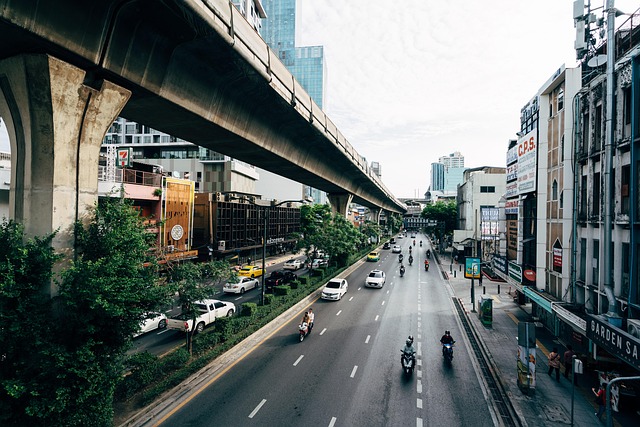Karachi's Cantt area faces significant traffic congestion due to rapid urbanization and population growth. By analyzing data, authorities can identify peak travel times, congested routes, and implement strategic solutions like optimizing signal timings and dynamic pricing. Understanding distinct land-use patterns is crucial for enhancing traffic flow and reducing jams. Karachi embraces smart city initiatives, including real-time traffic monitoring and efficient public transport networks, to revolutionize transportation and improve mobility, contributing to environmental sustainability. Innovative solutions like electric vehicles and digital technology promise a greener, more livable future for the bustling metropolis.
Karachi’s Cantt area, a bustling hub of activity, often faces significant traffic challenges. This article delves into the intricate world of traffic updates, exploring the unique patterns and factors shaping mobility in this vibrant city. From understanding congestion hotspots to examining the impact of urban development on road networks, we uncover insights that inform innovative solutions. Additionally, we gaze into the future, presenting prospects for enhanced traffic management and improved connectivity within Karachi.
- Understanding Traffic Patterns in Karachi's Cantt Area
- Key Factors Influencing Traffic Congestion
- Impact of Urban Development on Road Network
- Innovative Solutions for Better Traffic Management
- Future Prospects: Enhancing Mobility in Cantt, Karachi
Understanding Traffic Patterns in Karachi's Cantt Area

The sprawling metropolis of Karachi, particularly its Cantt area, presents a unique challenge when it comes to traffic management due to its dense population and complex urban layout. Understanding the intricate traffic patterns in this vibrant city is crucial for implementing effective solutions. By studying historical data and real-time metrics, authorities can identify peak travel times, congested routes, and areas prone to traffic jams. This knowledge allows for strategic planning, such as adjusting signal timings, designating high-capacity lanes, and introducing dynamic pricing on toll roads.
In the heart of Karachi, Cantt Area experiences distinct traffic flows based on its diverse landuse. Commuters from residential neighborhoods and nearby towns converge on major thoroughfares during peak hours, while commercial activities along the coast create a constant ebb and flow of vehicles throughout the day. By delving into these patterns, transport planners can make informed decisions to enhance the overall traffic experience, ensuring smoother commutes and reducing congestion in this bustling part of Karachi.
Key Factors Influencing Traffic Congestion

In Karachi, traffic congestion is a complex issue influenced by several key factors. One primary cause is the rapid urbanization and population growth which has led to an increase in the number of vehicles on the road. The city’s infrastructure, while expansive, often struggles to keep up with this demand, resulting in congested thoroughfares, especially during peak hours.
Another significant contributor is the lack of efficient public transportation systems. With most residents relying on personal vehicles for daily commutes, the strain on roads intensifies. Additionally, poor traffic management and enforcement of traffic rules play a role. Unregulated parking, jams at intersections, and inadequate signage all contribute to the perpetual traffic snarls that have become a familiar part of Karachi’s urban landscape.
Impact of Urban Development on Road Network

The rapid urban development in Karachi has significantly impacted its road network, leading to both challenges and opportunities. As the city expands, the demand for better infrastructure increases, putting pressure on existing roads. This is particularly evident in areas like Cantt, where high population density and an influx of vehicles have resulted in severe traffic congestion. The strain on the road network is further exacerbated by inadequate maintenance and planning, causing daily commutes to become lengthy and stressful for residents.
However, this urban growth also presents a chance to modernize and optimize Karachi’s transportation system. Smart city initiatives can play a pivotal role in addressing these issues by incorporating innovative solutions like real-time traffic monitoring, efficient signal timing, and well-planned public transport networks. By leveraging technology and adopting future-forward strategies, the road network can become more responsive, reducing congestion and enhancing overall mobility in this bustling metropolis.
Innovative Solutions for Better Traffic Management

In Karachi, a bustling metropolis with ever-growing traffic congestion, innovative solutions are more crucial than ever for efficient traffic management. Technologies such as smart sensors and real-time data analysis can optimize signal timings at intersections, reducing travel times and minimizing fuel consumption. Additionally, mobile apps that provide live traffic updates enable commuters to make informed choices, avoiding heavily congested routes.
These advanced measures not only enhance the flow of traffic but also contribute to environmental sustainability by lowering carbon emissions. The city’s commitment to adopting these innovative solutions is a step towards transforming Karachi into a model urban center for efficient and eco-friendly transportation, improving quality of life for its residents.
Future Prospects: Enhancing Mobility in Cantt, Karachi

The future of mobility in Cantt, Karachi, holds immense potential for transformation and enhancement. With a growing population and increasing urbanisation, the city faces challenges in managing traffic congestion, especially during peak hours. However, innovative solutions are on the horizon to revolutionise how residents and commuters navigate through this bustling metropolis.
One promising prospect is the implementation of smart transportation systems, leveraging digital technology to optimise traffic flow. This includes advanced traffic management centres that monitor real-time data, enabling efficient signal timings and route guidance. Additionally, the introduction of electric vehicle (EV) infrastructure, such as charging stations, can significantly reduce emissions and encourage a greener transport ecosystem in Karachi. These future prospects not only aim to ease congestion but also contribute to a more sustainable and livable city for all its residents.
The intricate traffic dynamics of Karachi’s Cantt area demand a multifaceted approach to management. By understanding the region’s unique traffic patterns and addressing factors like urban development, we can implement innovative solutions for smoother mobility. Future prospects for Cantt, Karachi look bright with the potential for enhanced infrastructure and smarter transportation systems, promising relief from congestion and improving quality of life for its residents.
